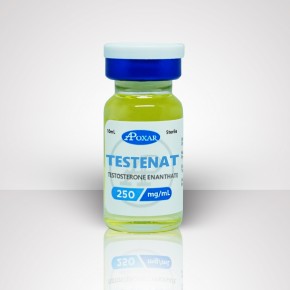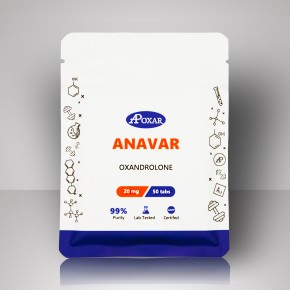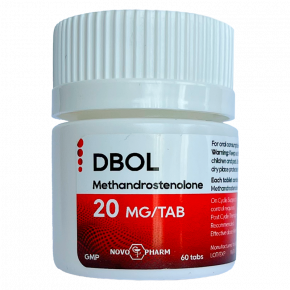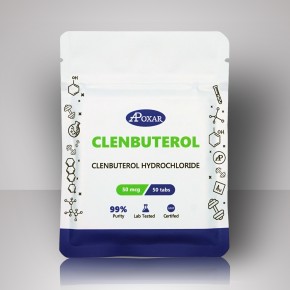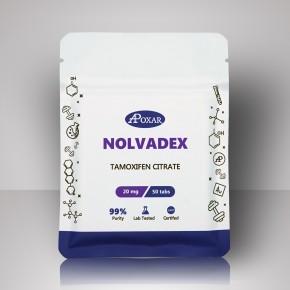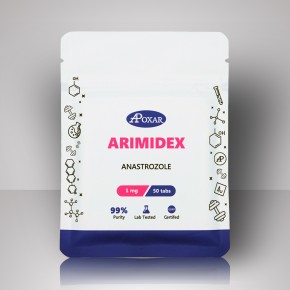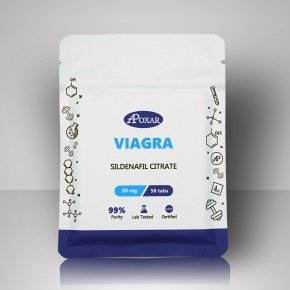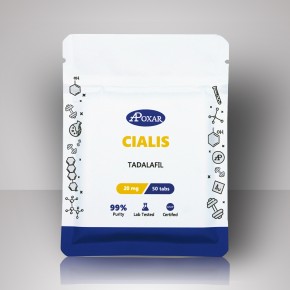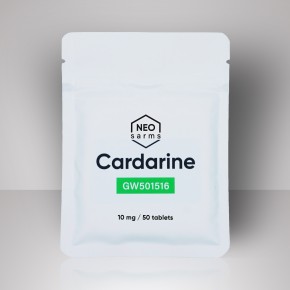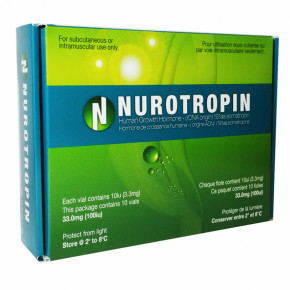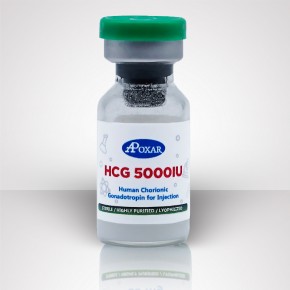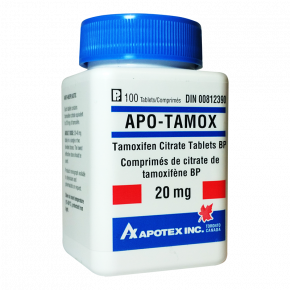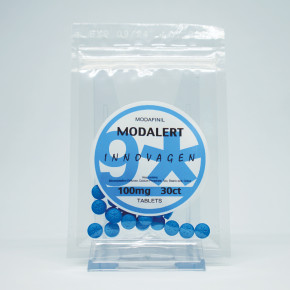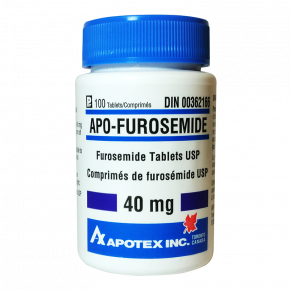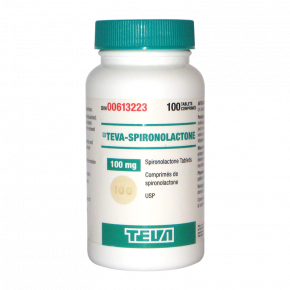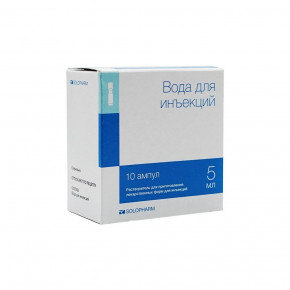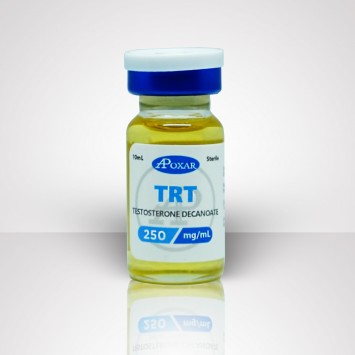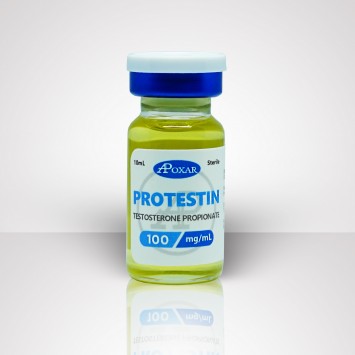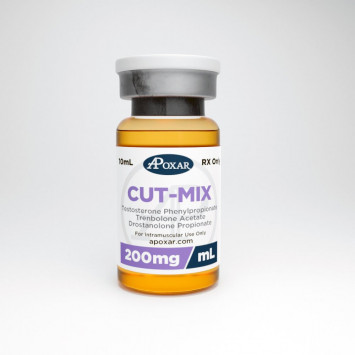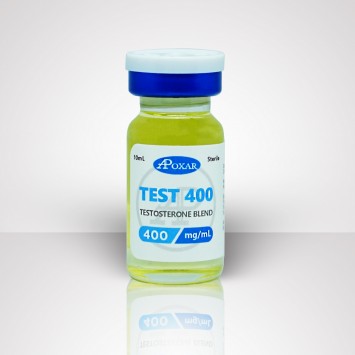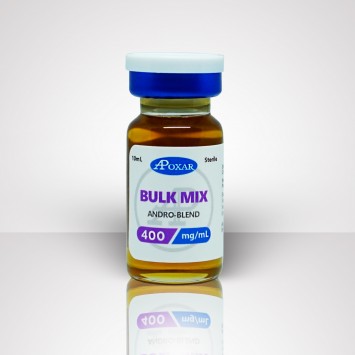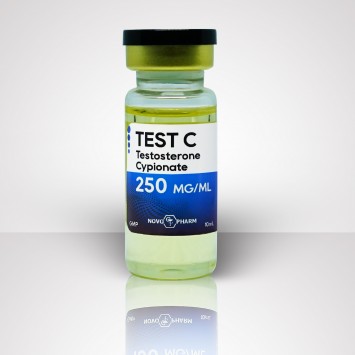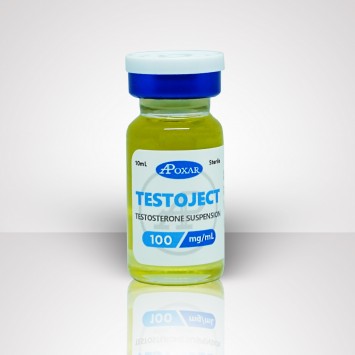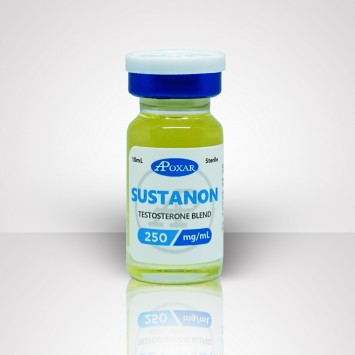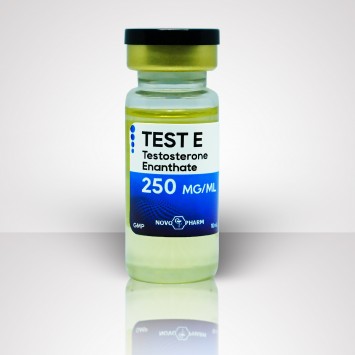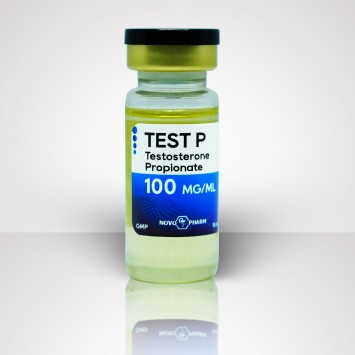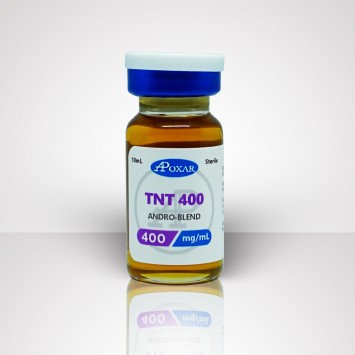 Free delivery for orders over $400
Free delivery for orders over $400Testosterone
The golden standard for every steroid. Testosterone is the most solid and well-researched way to increase your muscle mass, strength and sexual performance. Base of any steroid cycle. 250-1000mg/week 8-12 weeks
-
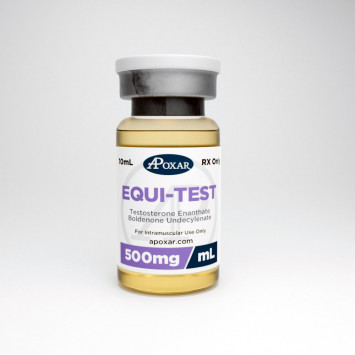
EquiTest (Boldenone + Test E) Blend 500mg/ml - Apoxar
$140.00Out of stock
-
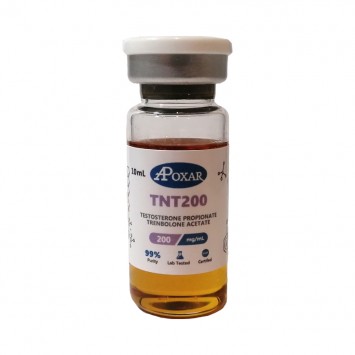
TNT 200 (Test Prop/Tren A) Blend - 200mg/ml - Apoxar
$100.00Out of stock
-
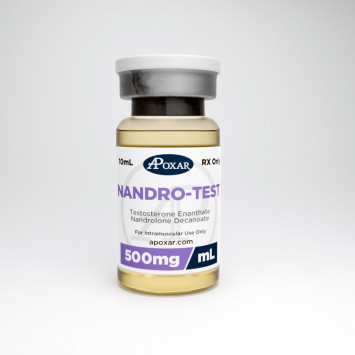
NandroTest (Deca/Test E) Blend 500mg/ml - Apoxar
$140.00Out of stock
-
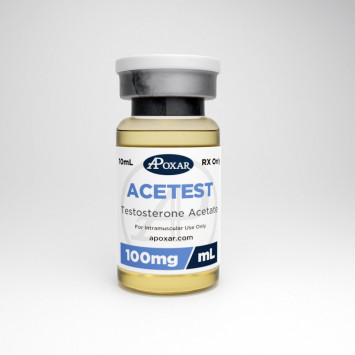
Testosterone Acetate 100mg/ml - Apoxar
$70.00Out of stock
-
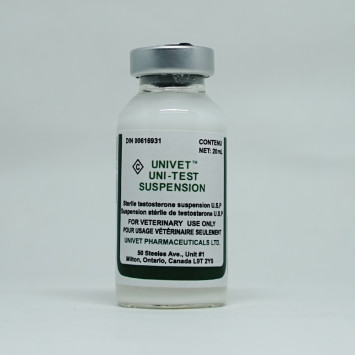
Testosterone Suspension 100mg/20ml - Univet
$140.00Out of stock
Testosterone enanthate
Testosterone enanthate is a slow-acting injectable form of the androgen testosterone. Following deep intramuscular injection, the drug is designed to provide a sustained release of testosterone into the bloodstream for approximately 2 to 3 weeks. In order to maintain normal physiological levels of testosterone during androgen replacement therapies, injections of testosterone enanthate are usually required at least every two weeks, although more meticulous physicians will administer the drug weekly. As with all testosterone injectables, testosterone enanthate is highly favored by athletes for its ability to promote strong increases in muscle mass and strength.
History
Testosterone enanthate first appeared on Western drug markets during the early 1950s. It was the first slow-acting oil-based injectable ester of testosterone to be widely adopted in Western medicine, and effectively replaced testosterone propionate and testosterone suspension for most therapeutic uses. The first brand of this drug to be sold in the U.S. was Delatestryl® by Squibb. Over the years the Delatestryl® brand has changed hands several times, most notably to Mead Johnson, BTG, Savient, and in December 2005, Indevus. The most prominent brand of testosterone enanthate outside of the United States is Testoviron®, a drug that has seen uninterrupted production by the same manufacturer (Schering AG, Germany) for more than 50 years. Globally, the Testoviron® brand from Schering is the single most widely used injectable testosterone preparation.
Testosterone enanthate is most often used clinically to replace normal levels of testosterone in Adult males suffering diminished androgen levels. This may manifest itself with a loss of libido, lean muscle mass, and normal energy and vigor. Testosterone enanthate is also used to treat undescended testicles and delayed puberty in adolescent males, and occasionally as a secondary medication during inoperable breast cancer in women. This form of testosterone has also been studied with great success as a male birth control option.1 Weekly injections of 200 mg were shown to efficiently lower sperm production for most men within three months of treatment, a state of suppression that remained until after the drug was discontinued. With the current stigma surrounding anabolic/androgenic steroids, however, it is unlikely that such therapy will become adopted in Western medical practice. Today, in spite of the growing number of alternative therapies, testosterone enanthate remains the most widely prescribed form of testosterone in the world.
How Supplied
Testosterone enanthate is widely available in human and veterinary drug markets. Composition and dosage may vary by country and manufacturer, but usually contain 50 mg/ml, 100 mg/ml, 200 mg/ml, or 250 mg/ml of steroid dissolved in oil.
Structural Characteristics
Testosterone enanthate is a modified form of testosterone, where a carboxylic acid ester (enanthate acid) has been attached to the 17-beta hydroxyl group. Esterified forms of testosterone are less polar than free testosterone and are absorbed more slowly from the area of injection. Once in the bloodstream, the ester is removed to yield free (active) testosterone. Esterified forms of testosterone are designed to prolong the window of therapeutic effect following administration, allowing for a less frequent injection schedule compared to injections of free (unesterified) steroid. The half-life of testosterone enanthate is approximately eight days after injection.
Side Effects (Estrogenic)
Testosterone is readily aromatized in the body to estradiol (estrogen). The aromatase (estrogen synthetase) enzyme is responsible for this metabolism of testosterone. Elevated estrogen levels can cause side effects such as increased water retention, body fat gain, and gynecomastia. Testosterone is considered a moderately estrogenic steroid. An anti-estrogen such as clomiphene citrate or tamoxifen citrate may be necessary to prevent estrogenic side effects. One may alternately use an aromatase inhibitor like Arimidex® (anastrozole), which more efficiently controls estrogen by preventing its synthesis. Aromatase inhibitors can be quite expensive in comparison to anti-estrogens, however, and may also have negative effects on blood lipids.
Estrogenic side effects will occur in a dose-dependent manner, with higher doses (above normal therapeutic levels) of testosterone more likely to require the concurrent use of an anti-estrogen or aromatase inhibitor. Since water retention and loss of muscle definition are common with higher doses of testosterone, this drug is usually considered a poor choice for dieting or cutting phases of training. Its moderate estrogenicity makes it more ideal for bulking phases, where the added water retention will support raw strength and muscle size, and help foster a stronger anabolic environment.
Side Effects (Androgenic)
Testosterone is the primary male androgen, responsible for maintaining secondary male sexual characteristics. Elevated levels of testosterone are likely to produce androgenic side effects including oily skin, acne, and body/facial hair growth. Men with a genetic predisposition for hair loss (androgenetic alopecia) may notice accelerated male pattern balding. Those concerned about hair loss may find a more comfortable option in nandrolone decanoate, which is a comparably less androgenic steroid. Women are warned of the potential virilizing effects of anabolic/androgenic steroids, especially with a strong androgen such as testosterone. These may include deepening of the voice, menstrual irregularities, changes in skin texture, facial hair growth, and clitoral enlargement.
In androgen-responsive target tissues such as the skin, scalp, and prostate, the high relative androgenicity of testosterone is dependant on its reduction to dihydrotestosterone (DHT). The 5-alpha reductase enzyme is responsible for this metabolism of testosterone. The concurrent use of a 5-alpha reductase inhibitor such as finasteride or dutasteride will interfere with site-specific potentiation of testosterone action, lowering the tendency of testosterone drugs to produce androgenic side effects. It is important to remember that anabolic and androgenic effects are both mediated via the cytosolic androgen receptor. Complete separation of testosterone’s anabolic and androgenic properties is not possible, even with total 5-alpha reductase inhibition.
Side Effects (Hepatotoxicity)
Testosterone does not have hepatotoxic effects; liver toxicity is unlikely. One study examined the potential for hepatotoxicity with high doses of testosterone by administering 400 mg of the hormone per day (2,800 mg per week) to a group of male subjects. The steroid was taken orally so that higher peak concentrations would be reached in hepatic tissues compared to intramuscular injections. The hormone was given daily for 20 days and produced no significant changes in liver enzyme values including serum albumin, bilirubin, alanine-amino-transferase, and alkaline phosphatases.
Side Effects (Cardiovascular)
Anabolic/androgenic steroids can have deleterious effects on serum cholesterol. This includes a tendency to reduce HDL (good) cholesterol values and increase LDL (bad) cholesterol values, which may shift the HDL to LDL balance in a direction that favors greater risk of arteriosclerosis. The relative impact of an anabolic/androgenic steroid on serum lipids is dependant on the dose, route of administration (oral vs. injectable), type of steroid (aromatizable or non-aromatizable), and level of resistance to hepatic metabolism. Anabolic/androgenic steroids may also adversely effect blood pressure and triglycerides, reduce endothelial relaxation, and support left ventricular hypertrophy, all potentially increasing the risk of cardiovascular disease and myocardial infarction.
Testosterone tends to have a much less dramatic impact on cardiovascular risk factors than synthetic steroids. This is due in part to its openness to metabolism by the liver, which allows it to have less effect on the hepatic management of cholesterol. The aromatization of testosterone to estradiol also helps to mitigate the negative effects of androgens on serum lipids. In one study, 280 mg per week of testosterone ester (enanthate) had a slight but not statistically significant effect on HDL cholesterol after 12 weeks, but when taken with an aromatase inhibitor a strong (25%) decrease was seen. Studies using 300 mg of testosterone ester (enanthate) per week for 20 weeks without an aromatase inhibitor demonstrated only a 13% decrease in HDL cholesterol, while at 600 mg the reduction reached 21%. The negative impact of aromatase inhibition should be taken into consideration before such a drug is added to testosterone therapy.
Due to the positive influence of estrogen on serum lipids, tamoxifen citrate or clomiphene citrate are preferred to aromatase inhibitors for those concerned with cardiovascular health, as they offer a partial estrogenic effect in the liver. This allows them to potentially improve lipid profiles and offset some of the negative effects of androgens. With doses of 600 mg or less per week, the impact on lipid profile tends to be noticeable but not dramatic, making an anti-estrogen (for cardioprotective purposes) perhaps unnecessary. Doses of 600 mg or less per week have also failed to produce statistically significant changes in LDL/VLDL cholesterol, triglycerides, apolipoprotein B/C-III, C-reactive protein, and insulin sensitivity, all indicating a relatively weak impact on cardiovascular risk factors. When used in moderate doses, injectable testosterone esters are usually considered to be the safest of all anabolic/androgenic steroids.
To help reduce cardiovascular strain it is advised to maintain an active cardiovascular exercise program and minimize the intake of saturated fats, cholesterol, and simple carbohydrates at all times during active AAS administration. Supplementing with fish oils (4 grams per day) and a natural cholesterol/antioxidant formula such as Lipid Stabil or a product with comparable ingredients is also recommended.
Side Effects (Testosterone Suppression)
All anabolic/androgenic steroids, when taken in doses sufficient to promote muscle gain, are expected to suppress endogenous testosterone production. Testosterone is the primary male androgen and offers strong negative feedback on endogenous testosterone production. Testosterone-based drugs will, likewise, have a strong effect on the hypothalamic regulation of natural steroid hormones. Without the intervention of testosterone-stimulating substances, testosterone levels should return to normal within 1-4 months of drug secession. Note that prolonged hypogonadotrophic hypogonadism can develop secondary to steroid abuse, necessitating medical intervention.
As with all anabolic/androgenic steroids, it is unlikely that one will retain every pound of new bodyweight after a cycle is concluded. This is especially true when withdrawing from a strong (aromatizing) androgen like testosterone, as much of the new weight gain is likely to be in the form of water retention; quickly eliminated after drug discontinuance. An imbalance of anabolic and catabolic hormones during the post-cycle recovery period may further create an environment that is unfavorable for the retention of muscle tissue. Proper ancillary drug therapy is usually recommended to help restore hormonal balance more quickly, ultimately helping the user retain more muscle tissue.
Administration (Men)
To treat androgen insufficiency, the prescribing guidelines for testosterone enanthate call for a dosage of 50-400 mg every 2 to 4 weeks. Although active in the body for a longer time, testosterone enanthate is usually injected on a weekly basis for muscle-building purposes. The usual dosage for physique- or performance-enhancing purposes is in the range of 200-600 mg per week, taken in cycles 6 to 12 weeks in length. This level is sufficient for most users to notice exceptional gains in muscle size and strength.
Testosterone is usually incorporated into bulking phases of training when added water retention will be of little consequence, the user more concerned with raw mass than definition. Some do incorporate the drug into cutting cycles as well, but typically in lower doses (100- 200 mg per week) and/or when accompanied by an aromatase inhibitor to keep estrogen levels under control. Testosterone enanthate is a very effective anabolic drug and is often used alone with great benefit. Some, however, find a need to stack it with other anabolic/androgenic steroids for a stronger effect, in which case an additional 200-400 mg per week of boldenone undecylenate, methenolone enanthate, or nandrolone decanoate should provide substantial results with no significant hepatotoxicity. Testosterone is ultimately very versatile and can be combined with many other anabolic/androgenic steroids to tailor the desired effect.
Administration (Women)
Testosterone enanthate is rarely used with women in clinical medicine. When applied, it is most often used as a secondary medication during inoperable breast cancer, when other therapies have failed to produce a desirable effect and suppression of ovarian function is necessary. Testosterone enanthate is not recommended for women for physique- or performance-enhancing purposes due to its strong androgenic nature, tendency to produce virilizing side effects, and slow-acting characteristics (making blood levels difficult to control).
Availability
Testosterone enanthate remains the most widely manufactured form of injectable testosterone worldwide and is produced in many generic and brand name forms.
References
Testosterone Сypionate
Testosterone cypionate is a slow-acting injectable ester of the primary male androgen testosterone. Testosterone is also the principle anabolic hormone in men and is the basis of comparison by which all other anabolic/androgenic steroids are judged. As with all testosterone injectables, testosterone cypionate is highly favored by athletes for its ability to promote strong increases in muscle mass and strength. It is interesting to note that while a large number of other steroidal compounds have been made available since testosterone injectables, they are still considered to be the dominant bulking agents among bodybuilders. There is little argument that these are among the most powerful mass drugs available, testosterone cypionate included.
History
Testosterone cypionate first appeared on the U.S. drug market during the mid-1950s under the brand name of Depo-Testosterone cyclopentylpropionate (soon abridged to simply Depo-Testosterone). It was developed by the pharmaceutical giant Upjohn and is still sold to this day by the same company under the same trade name (although now they are called Pharmacia & Upjohn). This is a drug with limited global availability and has historically been (largely) identified as an American item. It is not surprising that American athletes have long favored this form of testosterone over testosterone enanthate, the dominant slow-acting ester of testosterone on the global market. This preference, however, is likely rooted in history and availability, not actual therapeutic advantages.
Testosterone cypionate and testosterone enanthate provide extremely comparable patterns of testosterone release. Not only are physical advantages not possible in one over the other, but actual differences in pharmacokinetic patterns are hard to notice (these two drugs are for all intents and purposes functionally interchangeable). The only key difference between the two seems to be in the area of patient comfort. Cypionic acid is less irritating at the site of injection than enanthate acid (enanthate) for a small percentage of patients. This makes testosterone cypionate a more favorable choice for those with recurring issues of injection-site pain with testosterone enanthate. This difference likely had something to do with the early development of this testosterone ester as a commercial drug product.
The main use of testosterone cypionate in clinical medicine has historically been the treatment of low androgen levels in males, although many other applications have existed for this drug as well. During the 1960s, for example, the drug’s prescribing recommendations called for such uses as supporting bone structure maturity, treating menorrhagia (heavy menstrual bleeding) and excessive lactation in females, and increasing muscle mass and combating osteoporosis in the elderly. It was also being recommended for increasing male fertility, whereby induced testosterone/spermatogenesis suppression (caused by administering 200 mg of testosterone cypionate per week for 6 to 10 weeks) was potentially followed by a period of rebound spermatogenesis (due to temporarily higher than normal gonadotropin levels).
By the 1970s, the FDA had been granted much stronger control over the prescription drug market, and the broad uses in which testosterone cypionate was first indicated were now being refined. For example, “testosterone rebound therapy” as a way to increase male fertility was proving to be unreliable, especially in the face of newer more effective medications, and was soon eliminated from prescribing guidelines. So too was the recommendation for its use to treat things like excessive menstrual bleeding and lactation. In general, testosterone therapy was being pulled back to focus mainly on male androgen deficiency, and less on other applications, especially when involving populations more susceptible to androgenic side effects, such as women and the elderly.
Today, testosterone cypionate remains readily available on the U.S. prescription drug market, where it is FDA-approved for hormone replacement therapy in men with conditions associated with a deficiency of endogenous testosterone, and as a secondary treatment for inoperable metastatic breast cancer in women (although it is not widely used for this purpose anymore). Testosterone cypionate is currently available outside of the United States, but not widely. Known international sources for the drug include Canada, Australia, Spain, Brazil, and South Africa.
How Supplied
Testosterone cypionate is available in select human and veterinary drug markets. Composition and dosage may vary by country and manufacturer, but usually contain 50 mg/ml, 100 mg/ml, 125 mg/ml, or 200 mg/ml of steroid dissolved in oil.
Structural Characteristics
Testosterone cypionate is a modified form of testosterone, where a carboxylic acid ester (cyclopentylpropionic acid) has been attached to the 17-beta hydroxyl group. Esterified forms of testosterone are less polar than free testosterone and are absorbed more slowly from the area of injection. Once in the bloodstream, the ester is removed to yield free (active) testosterone. Esterified forms of testosterone are designed to prolong the window of therapeutic effect following administration, allowing for a less frequent injection schedule compared to injections of free (unesterified) steroid. The half-life of testosterone cypionate is approximately 8 days after injection.
Testosterone is readily aromatized in the body to estradiol (estrogen). The aromatase (estrogen synthetase) enzyme is responsible for this metabolism of testosterone. Elevated estrogen levels can cause side effects such as increased water retention, body fat gain, and gynecomastia. Testosterone is considered a moderately estrogenic steroid. An anti-estrogen such as clomiphene citrate or tamoxifen citrate may be necessary to prevent estrogenic side effects. One may alternately use an aromatase inhibitor like Arimidex® (anastrozole), which more efficiently controls estrogen by preventing its synthesis. Aromatase inhibitors can be quite expensive in comparison to anti-estrogens, however, and may also have negative effects on blood lipids.
Estrogenic side effects will occur in a dose-dependent manner, with higher doses (above normal therapeutic levels) of testosterone cypionate more likely to require the concurrent use of an anti-estrogen or aromatase inhibitor. Since water retention and loss of muscle definition are common with higher doses of testosterone cypionate, this drug is usually considered a poor choice for dieting or cutting phases of training. Its moderate estrogenicity makes it more ideal for bulking phases, where the added water retention will support raw strength and muscle size, and help foster a stronger anabolic environment.
Side Effects (Androgenic)
Testosterone is the primary male androgen, responsible for maintaining secondary male sexual characteristics. Elevated levels of testosterone are likely to produce androgenic side effects including oily skin, acne, and body/facial hair growth. Men with a genetic predisposition for hair loss (androgenetic alopecia) may notice accelerated male pattern balding. Those concerned about hair loss may find a more comfortable option in nandrolone decanoate, which is a comparably less androgenic steroid. Women are warned of the potential virilizing effects of anabolic/androgenic steroids, especially with a strong androgen such as testosterone. These may include deepening of the voice, menstrual irregularities, changes in skin texture, facial hair growth, and clitoral enlargement.
In androgen-responsive target tissues such as the skin, scalp, and prostate, the high relative androgenicity of testosterone is dependant on its reduction to dihydrotestosterone (DHT). The 5-alpha reductase enzyme is responsible for this metabolism of testosterone. The concurrent use of a 5-alpha reductase inhibitor such as finasteride or dutasteride will interfere with site-specific potentiation of testosterone action, lowering the tendency of testosterone drugs to produce androgenic side effects. It is important to remember that anabolic and androgenic effects are both mediated via the cytosolic androgen receptor. Complete separation of testosterone’s anabolic and androgenic properties is not possible, even with total 5-alpha reductase inhibition.
Side Effects (Hepatotoxicity)
Testosterone does not have hepatotoxic effects; liver toxicity is unlikely. One study examined the potential for hepatotoxicity with high doses of testosterone by administering 400 mg of the hormone per day (2,800 mg per week) to a group of male subjects. The steroid was taken orally so that higher peak concentrations would be reached in hepatic tissues compared to intramuscular injections. The hormone was given daily for 20 days and produced no significant changes in liver enzyme values including serum albumin, bilirubin, alanine-amino-transferase, and alkaline phosphatases.
Side Effects (Cardiovascular)
Anabolic/androgenic steroids can have deleterious effects on serum cholesterol. This includes a tendency to reduce HDL (good) cholesterol values and increase LDL (bad) cholesterol values, which may shift the HDL to LDL balance in a direction that favors greater risk of arteriosclerosis. The relative impact of an anabolic/androgenic steroid on serum lipids is dependant on the dose, route of administration (oral vs. injectable), type of steroid (aromatizable or non-aromatizable), and level of resistance to hepatic metabolism. Anabolic/androgenic steroids may also adversely affect blood pressure and triglycerides, reduce endothelial relaxation, and support left ventricular hypertrophy, all potentially increasing the risk of cardiovascular disease and myocardial infarction.
Testosterone tends to have a much less dramatic impact on cardiovascular risk factors than synthetic steroids. This is due in part to its openness to metabolism by the liver, which allows it to have less effect on the hepatic management of cholesterol. The aromatization of testosterone to estradiol also helps to mitigate the negative effects of androgens on serum lipids. In one study, 280 mg per week of testosterone ester (enanthate) had a slight but not statistically significant effect on HDL cholesterol after 12 weeks, but when taken with an aromatase inhibitor a strong (25%) decrease was seen. Studies using 300 mg of testosterone ester (enanthate) per week for 20 weeks without an aromatase inhibitor demonstrated only a 13% decrease in HDL cholesterol, while at 600 mg the reduction reached 21%.1 The negative impact of aromatase inhibition should be taken into consideration before such drug is added to testosterone therapy.
Due to the positive influence of estrogen on serum lipids, tamoxifen citrate or clomiphene citrate are preferred to aromatase inhibitors for those concerned with cardiovascular health, as they offer a partial estrogenic effect in the liver. This allows them to potentially improve lipid profiles and offset some of the negative effects of androgens. With doses of 600 mg or less per week, the impact on lipid profile tends to be noticeable but not dramatic, making an anti-estrogen (for cardioprotective purposes) perhaps unnecessary. Doses of 600 mg or less per week have also failed to produce statistically significant changes in LDL/VLDL cholesterol, triglycerides, apolipoprotein B/C-III, C-reactive protein, and insulin sensitivity, all indicating a relatively weak impact on cardiovascular risk factors.2 When used in moderate doses, injectable testosterone esters are usually considered to be the safest of all anabolic/androgenic steroids.
To help reduce cardiovascular strain it is advised to maintain an active cardiovascular exercise program and minimize the intake of saturated fats, cholesterol, and simple carbohydrates at all times during active AAS administration. Supplementing with fish oils (4 grams per day) and a natural cholesterol/antioxidant formula such as Lipid Stabil or a product with comparable ingredients is also recommended.
Side Effects (Testosterone Suppression)
All anabolic/androgenic steroids, when taken in doses sufficient to promote muscle gain, are expected to suppress endogenous testosterone production. Testosterone is the primary male androgen and offers strong negative feedback on endogenous testosterone production. Testosterone-based drugs will, likewise, have a strong effect on the hypothalamic regulation of natural steroid hormones. Without the intervention of testosterone-stimulating substances, testosterone levels should return to normal within 1-4 months of drug secession. Note that prolonged hypogonadotrophic hypogonadism can develop secondary to steroid abuse, necessitating medical intervention.
As with all anabolic/androgenic steroids, it is unlikely that one will retain every pound of new bodyweight after a cycle is concluded. This is especially true when withdrawing from a strong (aromatizing) androgen like testosterone cypionate, as much of the new weight gain is likely to be in the form of water retention, quickly eliminated after drug discontinuance. An imbalance of anabolic and catabolic hormones during the post-cycle recovery period may further create an environment that is unfavorable for the retention of muscle tissue. Proper ancillary drug therapy is usually recommended to help restore hormonal balance more quickly, ultimately helping the user retain more muscle tissue.
Another way to lessen the post-cycle “crash” is to first replace testosterone cypionate with a milder anabolic such as nandrolone decanoate or methenolone enanthate. The new steroid would be administered alone for one to two more months, at a dosage of 200-400 mg per week. In this “stepping down” procedure the user is attempting to eliminate the watery bulk of a testosterone-based drug while simultaneously preserving the solid muscularity underneath. This practice can prove to be effective, even if mainly for psychological reasons (some may view it as simply dividing the crash into the water and hormonal stages). Testosterone-stimulating drugs are still typically used at the conclusion of therapy, as endogenous testosterone production will not rebound during the administration of nandrolone decanoate or methenolone enanthate.
Administration (Men)
To treat low testosterone levels, the prescribing guidelines for testosterone cypionate call for a dosage of 50-400 mg every two to four weeks. Although active in the body for a longer time, testosterone cypionate is usually injected on a weekly basis for physique- or performance-enhancing purposes. The usual dosage is in the range of 200-600 mg per week, taken in cycles 6 to 12 weeks in length. This level is sufficient for most users to notice exceptional gains in muscle size and strength.
Testosterone is usually incorporated into bulking phases of training when added water retention will be of little consequence, the user more concerned with raw mass than definition. Some do incorporate the drug into cutting cycles as well, but typically in lower doses (100- 200 mg per week) and/or when accompanied by an aromatase inhibitor to keep estrogen levels under control. Testosterone cypionate is a very effective anabolic drug and is often used alone with great benefit. Some, however, find a need to stack it with other anabolic/androgenic steroids for a stronger effect, in which case an additional 200-400 mg per week of boldenone undecylenate, methenolone enanthate, or nandrolone decanoate should provide substantial results with no significant hepatotoxicity. Testosterone is ultimately very versatile and can be combined with many other anabolic/androgenic steroids to tailor the desired effect.
While large doses are generally not advised, some bodybuilders have been known to use excessively high dosages of this drug (1,000 mg per week or more). This was much more common before the 1990s when cypionate vials were usually very cheap and easy to find. A “more is better” attitude is easy to justify when paying only $20 for a 10cc vial (today the typical price for a single injection). At dosages of 800-1000 mg per week or more, water retention will likely account for more of the additional weight gain than new muscle tissue. The practice of “megadosing” is inefficient (not to mention potentially dangerous), especially when we take into account the typical high cost of steroids today.
Administration (Women)
Testosterone cypionate is rarely used with women in clinical medicine. When applied, it is most often used as a secondary medication during inoperable breast cancer, when other therapies have failed to produce a desirable effect and suppression of ovarian function is necessary. Testosterone cypionate is not recommended for women for physique- or performance-enhancing purposes due to its strong androgenic nature, tendency to produce virilizing side effects, and slow-acting characteristics (making blood levels difficult to control).
Availability
Testosterone cypionate remains widely available as a prescription drug product. Its production is largely associated with American companies, although recently has been expanding into loosely regulated Asian markets that still cater to demand by bodybuilders and athletes.
References
- Testosterone dose-response relationships in healthy young men. Bhasin S, Woodhouse L et al. Am J Physiol Endocrinol Metab 281 (2001):E1172-81.
- The effects of varying doses of T on insulin sensitivity, plasma lipids, apolipoproteins, and C-reactive protein in healthy young men. Singh A, Hsia S, et al. J Clin Endocrinol Metab 87 (2002):136-43.
Testosterone Propionate
Testosterone propionate is a commonly manufactured injectable form of the primary male androgen testosterone. The added propionate ester will slow the rate in which testosterone is released from the injection site, but only for a few days. Testosterone propionate is, therefore, comparatively much faster-acting than other testosterone esters such as cypionate or enanthate, and requires a much more frequent dosing schedule. By most accounts, testosterone propionate is an older and cruder form of injectable testosterone, made obsolete by the slower-acting and more comfortable esters that were developed subsequent to it. Still, those who are not bothered by the frequent injection schedule find testosterone propionate every bit as acceptable. As an injectable testosterone, it is a powerful mass-building drug, capable of producing rapid gains in both muscle size and strength.
History
Testosterone propionate was first described in 1935, during a series of experiments that set out to increase the therapeutic use of testosterone by slowing its release into the bloodstream.1 Two years later, Schering AG in Germany would introduce the first testosterone propionate product under the brand name Testoviron®. Propionate was also the first commercially available injectable ester of testosterone on the U.S. prescription drug market and remained the dominant form of testosterone globally before 1960. Back during the early 1950s, for example, when steroids were first being experimented with by small numbers of American athletes, the only readily available anabolic/androgenic steroids were methyltestosterone, testosterone propionate, and testosterone suspension. Interestingly enough, during this time testosterone propionate was also available in orally administered (Buccal) preparations, but they disappeared from the U.S. market during the 1980s.
Early prescribing guidelines for testosterone propionate called for a number of therapeutic uses. It was mainly applied to cases of male androgen insufficiency, and those issues normally surrounding low testosterone levels such as reduced sex drive and impotence in adults, and cryptorchidism (undescended testicles) in teenagers and young adults. But it also had such other uses as treating menopause, menorrhagia (heavy menstrual bleeding), menstrual tension, chronic cystic mastitis (fibrocystic breasts), endometriosis, and excessive lactation, covering a wide range of situations in which the male hormone testosterone was being applied to female patients. Over the years these wide guidelines were narrowed by the U.S. Food & Drug Administration, however, and by the 1980s, testosterone propionate was being largely applied only to male patients.
Testosterone propionate has a long history of availability in the U.S. and abroad and remains a very common form of testosterone on the global market to this day. It must be emphasized, however, that its ability to remain on the market is more a product of history than a unique application. Testosterone propionate was the first acceptable ester of testosterone, and consequently has many decades of history as a useable therapeutic agent. Many companies have sold it for decades now, and so long as it is still in demand will continue to do so. But other (more modern) forms of testosterone such as enanthate and cypionate are much more popular today, as they are much slower-acting still, and allow for far more comfortable administration schedules. Testosterone propionate is still approved for sale in the United States, although its ultimate market future here remains questionable.
Bodybuilders commonly consider propionate to be the mildest testosterone ester and the preferred form of this hormone for dieting/cutting phases of training. Some will go so far as to say that propionate will harden the physique while giving the user less water and fat retention than one typically expects to see with a testosterone-like enanthate, cypionate or Sustanon. Realistically, however, these advantages do not hold up to close scrutiny. The propionate ester is actually removed before the testosterone it carries is active in the body, and ultimately has little effect outside of slowing steroid release. It all really boils down to how much testosterone you are getting into your blood with each particular esterified compound. Otherwise, there are no real functional differences between them.
How Supplied
Testosterone propionate is widely available in human and veterinary drug markets. Composition and dosage may vary by country and manufacturer, but usually contain 25 mg/ml, 50 mg/ml, or 100 mg/ml of steroid dissolved in oil.
Structural Characteristics
Testosterone propionate is a modified form of testosterone, where a carboxylic acid ester (propionic acid) has been attached to the 17-beta hydroxyl group. Esterified forms of testosterone are less polar than free testosterone and are absorbed more slowly from the area of injection. Once in the bloodstream, the ester is removed to yield free (active) testosterone. Esterified forms of testosterone are designed to prolong the window of therapeutic effect following administration, allowing for a less frequent injection schedule compared to injections of free (unesterified) steroid. The half-life of testosterone propionate is approximately two days after injection.
Side Effects (Estrogenic)
Testosterone is readily aromatized in the body to estradiol (estrogen). The aromatase (estrogen synthetase) enzyme is responsible for this metabolism of testosterone. Elevated estrogen levels can cause side effects such as increased water retention, body fat gain, and gynecomastia. Testosterone is considered a moderately estrogenic steroid. An anti-estrogen such as clomiphene citrate or tamoxifen citrate may be necessary to prevent estrogenic side effects. One may alternately use an aromatase inhibitor like Arimidex® (anastrozole), which more efficiently controls estrogen by preventing its synthesis. Aromatase inhibitors can be quite expensive in comparison to anti-estrogens, however, and may also have negative effects on blood lipids.
Estrogenic side effects will occur in a dose-dependent manner, with higher doses (above normal therapeutic levels) of testosterone propionate more likely to require the concurrent use of an anti-estrogen or aromatase inhibitor. Since water retention and loss of muscle definition are common with higher doses of testosterone, this drug is usually considered a poor choice for dieting or cutting phases of training. Its moderate estrogenicity makes it more ideal for bulking phases, where the added water retention will support raw strength and muscle size, and help foster a stronger anabolic environment.
Side Effects (Androgenic)
Testosterone is the primary male androgen, responsible for maintaining secondary male sexual characteristics. Elevated levels of testosterone are likely to produce androgenic side effects including oily skin, acne, and body/facial hair growth. Men with a genetic predisposition for hair loss (androgenetic alopecia) may notice accelerated male pattern balding. Those concerned about hair loss may find a more comfortable option in nandrolone decanoate, which is a comparably less androgenic steroid. Women are warned of the potential virilizing effects of anabolic/androgenic steroids, especially with a strong androgen such as testosterone. These may include deepening of the voice, menstrual irregularities, changes in skin texture, facial hair growth, and clitoral enlargement.
In androgen-responsive target tissues such as the skin, scalp, and prostate, the high relative androgenicity of testosterone is dependant on its reduction to dihydrotestosterone (DHT). The 5-alpha reductase enzyme is responsible for this metabolism of testosterone. The concurrent use of a 5-alpha reductase inhibitor such as finasteride or dutasteride will interfere with site-specific potentiation of testosterone action, lowering the tendency of testosterone drugs to produce androgenic side effects. It is important to remember that both anabolic and androgenic effects are mediated via the cytosolic androgen receptor. Complete separation of testosterone’s anabolic and androgenic properties is not possible, even with total 5-alpha reductase inhibition.
Side Effects (Hepatotoxicity)
Testosterone does not have hepatotoxic effects; liver toxicity is unlikely. One study examined the potential for hepatotoxicity with high doses of testosterone by administering 400 mg of the hormone per day (2,800 mg per week) to a group of male subjects. The steroid was taken orally so that higher peak concentrations would be reached in hepatic tissues compared to intramuscular injections. The hormone was given daily for 20 days and produced no significant changes in liver enzyme values including serum albumin, bilirubin, alanine-amino-transferase, and alkaline phosphatases.
Side Effects (Cardiovascular)
Anabolic/androgenic steroids can have deleterious effects on serum cholesterol. This includes a tendency to reduce HDL (good) cholesterol values and increase LDL (bad) cholesterol values, which may shift the HDL to LDL balance in a direction that favors greater risk of arteriosclerosis. The relative impact of an anabolic/androgenic steroid on serum lipids is dependant on the dose, route of administration (oral vs. injectable), type of steroid (aromatizable or non-aromatizable), and level of resistance to hepatic metabolism. Anabolic/androgenic steroids may also adversely affect blood pressure and triglycerides, reduce endothelial relaxation, and support left ventricular hypertrophy, all potentially increasing the risk of cardiovascular disease and myocardial infarction.
Testosterone tends to have a much less dramatic impact on cardiovascular risk factors than synthetic steroids. This is due in part to its openness to metabolism by the liver, which allows it to have less effect on the hepatic management of cholesterol. The aromatization of testosterone to estradiol also helps to mitigate the negative effects of androgens on serum lipids. In one study, 280 mg per week of testosterone ester (enanthate) had a slight but not statistically significant effect on HDL cholesterol after 12 weeks, but when taken with an aromatase inhibitor a strong (25%) decrease was seen. Studies using 300 mg of testosterone ester (enanthate) per week for twenty weeks without an aromatase inhibitor demonstrated only a 13% decrease in HDL cholesterol, while at 600 mg the reduction reached 21%. The negative impact of aromatase inhibition should be taken into consideration before such a drug is added to testosterone therapy.
Due to the positive influence of estrogen on serum lipids, tamoxifen citrate or clomiphene citrate are preferred to aromatase inhibitors for those concerned with cardiovascular health, as they offer a partial estrogenic effect in the liver. This allows them to potentially improve lipid profiles and offset some of the negative effects of androgens. With doses of 600 mg or less of testosterone per week, the impact on lipid profile tends to be noticeable but not dramatic, making an anti-estrogen (for cardioprotective purposes) perhaps unnecessary. Doses of 600 mg or less per week have also failed to produce statistically significant changes in LDL/VLDL cholesterol, triglycerides, apolipoprotein B/C-III, C-reactive protein, and insulin sensitivity, all indicating a relatively weak impact on cardiovascular risk factors. When used in moderate doses, injectable testosterone esters are usually considered to be the safest of all anabolic/androgenic steroids.
To help reduce cardiovascular strain it is advised to maintain an active cardiovascular exercise program and minimize the intake of saturated fats, cholesterol, and simple carbohydrates at all times during active AAS administration. Supplementing with fish oils (4 grams per day) and a natural cholesterol/antioxidant formula such as Lipid Stabil or a product with comparable ingredients is also recommended.
Side Effects (Testosterone Suppression)
All anabolic/androgenic steroids, when taken in doses sufficient to promote muscle gain, are expected to suppress endogenous testosterone production. Testosterone is the primary male androgen and offers strong negative feedback on endogenous testosterone production. Testosterone-based drugs will, likewise, have a strong effect on the hypothalamic regulation of natural steroid hormones. Without the intervention of testosterone-stimulating substances, testosterone levels should return to normal within 1-4 months of drug secession. Note that prolonged hypogonadotrophic hypogonadism can develop secondary to steroid abuse, necessitating medical intervention.
Administration (General)
Testosterone propionate is often regarded as a painful injection. This is due to the very short carbon chain of the propionic acid ester, which can be irritating to tissues at the site of injection. Many sensitive individuals choose to stay away from this steroid completely, their bodies reacting with a pronounced soreness and low-grade fever that may last for a few days after each injection. Even the mild soreness that is experienced by most users can be quite uncomfortable, especially when you take into account that the drug is being administered multiple times each week for a number of consecutive weeks.
Administration (Men)
To treat androgen insufficiency, early prescribing guidelines recommended a dosage of 25 mg given two to three times per week. Modern product literature usually recommends 25 mg to 50 mg given two to three times per week for the same purpose. The usual dosage among male athletes is in the range of 50-100 mg per injection, which is given every second or third day. Similar to other esters of testosterone, testosterone propionate is commonly used at a weekly cumulative dosage between 200 mg to 400 mg. This level is sufficient for most users to notice exceptional gains in muscle size and strength.
Testosterone propionate is usually incorporated into bulking phases of training when added water retention will be of little consequence, the user more concerned with raw mass than definition. Some do incorporate this drug into cutting cycles as well, but typically in lower doses (100-200 mg per week) and/or when accompanied by an aromatase inhibitor to keep estrogen levels under control. Testosterone propionate is a very effective anabolic drug and is often used alone with great benefit. Some, however, find a need to stack it with other anabolic/androgenic steroids for a stronger effect, in which case an additional 200-400 mg per week of boldenone undecylenate, methenolone enanthate, or nandrolone decanoate should provide substantial results with no significant hepatotoxicity. Testosterone is ultimately very versatile and can be combined with many other anabolic/androgenic steroids to tailor the desired effect.
Administration (Women)
Testosterone propionate is rarely used with women in clinical medicine. When applied, it is most often used as a secondary medication during inoperable breast cancer, when other therapies have failed to produce a desirable effect and suppression of ovarian function is necessary. Testosterone propionate is not recommended for women for performance-enhancing purposes due to its strong androgenic nature and tendency to produce virilizing side effects. Female bodybuilders who insist on using testosterone, however, often choose propionate, as blood levels are easier to control with this ester compared to cypionate or enanthate. Should virilization symptoms develop, hormone levels will decline in a matter of days, instead of weeks, following drug cessation? The administration schedule is often more conservative as well, with a small injection (25 mg at most) given every 5 to 7 days, and cycle duration limited to 6-8 weeks or less.
Availability
Testosterone propionate is subject to decreasing supply as a pharmaceutical product. Longer-acting esters such as cypionate and enanthate are much better suited for virtually every clinical application. As such, most physicians and pharmaceutical companies have abandoned this old ester of testosterone. With a few exceptions in the west, the remaining legitimate supply largely comes from manufacturers in loosely regulated markets of Asia, where black market demand continues to drive production.
References

